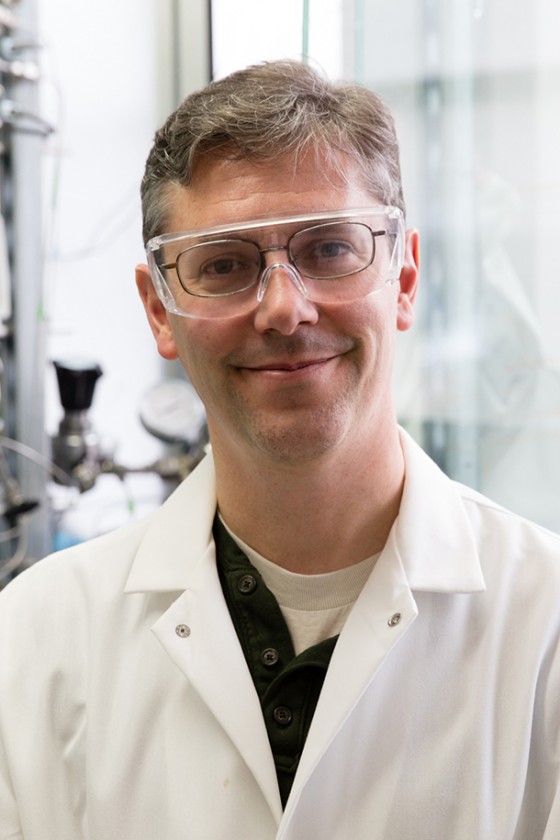
In this Sustainable Energy Seminar, George Huber, Professor of Chemical and Biological Engineering, will discuss different approaches for the production of renewable fuels from biomass, particularly lignocellulosic biomass, as well as industrial challenges and commercialization efforts for 2nd generation biofuels..
Registration is required for this webinar through Zoom. Click here to register for this and all other webinars as part of the Sustainable Energy Seminar series.
Abstract:
In this presentation we will discuss different approaches for the production of renewable fuels from biomass, particularly lignocellulosic biomass. The first step in all these approaches is depolymerization of lignocellulosic biomass by three different approaches: 1) gasification, 2) pyrolysis (or lower temperature liquefaction) or 3) low temperature hydrolysis. The grand challenge with these technologies is to convert as much of the energy of the biomass feedstock into a fungible liquid hydrocarbon that can fit into the existing petrochemical infrastructure as inexpensively and in as few as steps as possible. Unfortunately commercialization efforts for several of these technologies (cellulosic ethanol) have mostly failed because of the high capital cost and complicity of dealing with lignocellulosic feedstock. We will mention some of these industrial challenges.
Technoeconomic studies have reported that fast pyrolysis is the cheapest method to convert biomass into a liquid fuel. The resulting fast pyrolysis oil is an emulsion of oxygenated compounds that can be phase-separated into water-soluble and water-insoluble fractions by extraction with water. The water-soluble fraction of bio-oil contains sugars, anhydrosugars, acetic acid, hydroxyacetone, hydroxyacetaldehyde, furfural, and water soluble phenolics. The organic phase consists of phenolic oligomers that vary from 19-57 carbon number. Efforts to use existing FCC processes for conversion of the pyrolysis oils have resulted in large amounts of coke and light gases and low yields of liquid products. The yield of usable hydrocarbons (aromatics and olefins) for catalytic cracking of biomass derived molecules increases with an increasing hydrogen to carbon effective ratio of the biomass feed [1]. The hydrogen to carbon effective ratio can increase by hydrotreating the pyrolysis oil. However, hydrotreating of the pyrolysis oil also produces large amounts of coke which typically deactivates the catalyst bed after 70 hrs time on stream unless special measures are taken to treat the pyrolysis oil before hydrotreating. Renewable aromatics and olefins directly from biomass by the addition of zeolite catalysts directly into the pyrolysis reactor in a technology called catalytic fast pyrolysis (CFP) or Bio-TCat (www.anellotech.com).
Another alternative is to deconstruct the biomass into monomeric compounds by acid hydrolysis. Working with researchers at UC-Riverside and Wisconsin we have demonstrated a catalytic technology for the production of renewable diesel and jet fuel blendstocks from lignocellulosic biomass [3]. This process involves first separating the biomass into an aqueous hemicellulose stream and a cellulose/lignin stream by a hydrothermal treatment. The hemicellulose streams undergo an acid catalyzed dehydration step to produce furfural and acetic acid. In the dehydration reactions undesired humins are formed through reactions between the furfural and carbohydrates. The furfural then undergoes a C-C bond forming step followed by hydrogenation and hydrodeoxygenation to make diesel and jet fuel compounds. The cellulose/lignin feedstock is converted into levulinic acid and formic acid which is then further processed to make jet fuel range alkanes through a series of other reaction steps. While this approach may not be economically viable it illustrates the chemistry required for lower temperature conversion of biomass into distillate fuel molecules.
We will conclude this presentation by discussing commercialization efforts for 2nd generation biofuels. In the past decade over $1.0 billion in private and public funds has been spent on the development of pioneer technologies for the conversion of lignocellulosic biomass into liquid transportation fuels and chemicals. Several of these technologies have failed at the commercial level and several of these companies have now gone bankrupt. The failure of these technologies is due to two fundamental reasons: 1. economic estimates under predicted the costs of these technologies; and 2. pilot and demonstration plants operated well below their designed capacity. We will present a predictive model on how to estimate the economics and operability of pioneer technologies.
References
1. T. P. Vispute; H. Zhang; A. Sanna; R. Xiao; and G. W. Huber, Science (2010), 330, 1222-1227.
2. J Jae, R Coolman, TJ Mountziaris, GW Huber; Chemical Engineering Science (2014) 108, 33-46.
3. J Bond et al.; Energy and Environmental Science (2014) 7, 1657-1660.
